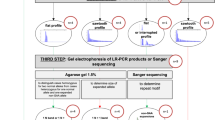Abstract
Introduction and Objective
Spinocerebellar ataxia type 3 (SCA3) is a polyglutamine (polyQ) disorder for which the routine molecular testing is based on PCR and automated capillary electrophoresis. When only a normal allele is detected by standard PCR, the hypothesis of a failed amplification of the expanded allele must be raised. In such cases, complementary techniques such as Southern Blot or triplet repeat primed PCR (TP-PCR) have to be applied. For SCA3, TP-PCR is implemented in some diagnostic laboratories, but a tested protocol has yet to be published. The purpose of this study was to develop and test a TP-PCR protocol for SCA3.
Methods
Sixty-five blood samples previously genotyped by standard PCR were used in the TP-PCR assay. Fourteen buccal swab samples were also analyzed to confirm the robustness of the technique. The reproducibility of the TP-PCR was evaluated by analyzing all samples in a second laboratory.
Results
The results obtained by TP-PCR confirmed the previous PCR results for 64 blood samples; in one sample an expanded allele, previously undetected by PCR, was identified. The results obtained for the buccal swab samples were totally concordant with those obtained for blood. Furthermore, the results obtained in the alternative laboratory were in full agreement with the results obtained in our study.
Conclusion
The present TP-PCR protocol developed for SCA3 should constitute a reliable complementary technique to overcome the limitations of standard PCR.


Similar content being viewed by others
References
de Castilhos RM, Furtado GV, Gheno TC, Schaeffer P, Russo A, Barsottini O, et al. Spinocerebellar ataxias in Brazil–frequencies and modulating effects of related genes. Cerebellum. 2014;13(1):17–28.
Ruano L, Melo C, Silva MC, Coutinho P. The global epidemiology of hereditary ataxia and spastic paraplegia: a systematic review of prevalence studies. Neuroepidemiology. 2014;42(3):174–83.
Kawaguchi Y, Okamoto T, Taniwaki M, Aizawa M, Inoue M, Katayama S, et al. CAG expansions in a novel gene for Machado-Joseph disease at chromosome 14q32.1. Nat Genet. 1994;8(3):221–8.
Takiyama Y, Nishizawa M, Tanaka H, Kawashima S, Sakamoto H, Karube Y, et al. The gene for Machado-Joseph disease maps to human chromosome 14q. Nat Genet. 1993;4(3):300–4.
Gan SR, Ni W, Dong Y, Wang N, Wu ZY. Population genetics and new insight into range of CAG repeats of spinocerebellar ataxia type 3 in the Han Chinese population. PLoS One. 2015;10(8):e0134405.
Durcan TM, Fon EA. Ataxin-3 and its e3 partners: implications for Machado-Joseph disease. Front Neurol. 2013;4:46.
Bettencourt C, Lima M. Machado-Joseph disease: from first descriptions to new perspectives. Orphanet J Rare Dis. 2011;6:35.
Butler JM. Chapter 5—short tandem repeat (STR) loci and kits. In: Butler JM, editor. Advanced topics in forensic DNA typing. San Diego: Academic Press; 2012. p. 99–139.
Sequeiros J, Martindale J, Seneca S, Giunti P, Kamarainen O, Volpini V, et al. EMQN best practice guidelines for molecular genetic testing of SCAs. Eur J Hum Genet. 2010;18(11):1173–6.
Trouba K. Southern and northern blotting. In: Vohr H-W, editor. Encyclopedic reference of immunotoxicology. Berlin, Heidelberg: Springer; 2005. p. 596–7.
Warner JP, Barron LH, Goudie D, Kelly K, Dow D, Fitzpatrick DR, et al. A general method for the detection of large CAG repeat expansions by fluorescent PCR. J Med Genet. 1996;33(12):1022–6.
Cagnoli C, Michielotto C, Matsuura T, Ashizawa T, Margolis RL, Holmes SE, et al. Detection of large pathogenic expansions in FRDA1, SCA10, and SCA12 genes using a simple fluorescent repeat-primed PCR assay. J Mol Diagn. 2004;6(2):96–100.
Cagnoli C, Stevanin G, Michielotto C, Gerbino Promis G, Brussino A, Pappi P, et al. Large pathogenic expansions in the SCA2 and SCA7 genes can be detected by fluorescent repeat-primed polymerase chain reaction assay. J Mol Diagn. 2006;8(1):128–32.
Falk M, Vojtísková M, Lukás Z, Kroupová I, Froster U. Simple procedure for automatic detection of unstable alleles in the myotonic dystrophy and Huntington’s disease loci. Genet Test. 2006;10(2):85–97.
Lyon E, Laver T, Yu P, Jama M, Young K, Zoccoli M, et al. A simple, high-throughput assay for fragile X expanded alleles using triple repeat primed PCR and capillary electrophoresis. J Mol Diagn. 2010;12(4):505–11.
Krysa W, Rajkiewicz M, Sulek A. Rapid detection of large expansions in progressive myoclonus epilepsy type 1, myotonic dystrophy type 2 and spinocerebellar ataxia type 8. Neurol Neurochir Pol. 2012;46(2):113–20.
Miller SA, Dykes DD, Polesky HF. A simple salting out procedure for extracting DNA from human nucleated cells. Nucleic Acids Res. 1988;16(3):1215.
Bettencourt C, Fialho RN, Santos C, Montiel R, Bruges-Armas J, Maciel P, et al. Segregation distortion of wild-type alleles at the Machado-Joseph disease locus: a study in normal families from the Azores islands (Portugal). J Hum Genet. 2008;53(4):333–9.
Raposo M, Ramos A, Bettencourt C, Lima M. Replicating studies of genetic modifiers in spinocerebellar ataxia type 3: can homogeneous cohorts aid? Brain. 2015;138(12):e398.
Author information
Authors and Affiliations
Corresponding author
Ethics declarations
Conflict of interest
ARVM, AR, NK, MR, BFB, ARR, TK, JV, JB-A and ML declare no conflicts of interests.
Ethical approval and informed consent
The present work was conducted as part of the ESMI project (European Spinocerebellar Ataxia Type 3/Machado-Joseph Disease Initiative) which was approved by the Ethical Board of the Hospital do Divino Espírito Santo (Ponta Delgada, Azores, Portugal). Informed consent was provided by all participants.
Funding
PhD fellowship M3.1.2/F/006/2011 (Mafalda Raposo) and postdoctoral fellowships M3.1.7/F/031/2011 (Amanda Ramos) and M3.1.3/F/004/2009 (Nadiya Kazachkova) were supported by Fundo Regional para a Ciência (FRC), Government of the Azores.
Additional information
A. R. V. Melo and A. Ramos contributed equally to this work.
Rights and permissions
About this article
Cite this article
Melo, A.R.V., Ramos, A., Kazachkova, N. et al. Triplet Repeat Primed PCR (TP-PCR) in Molecular Diagnostic Testing for Spinocerebellar Ataxia Type 3 (SCA3). Mol Diagn Ther 20, 617–622 (2016). https://doi.org/10.1007/s40291-016-0235-y
Published:
Issue Date:
DOI: https://doi.org/10.1007/s40291-016-0235-y




